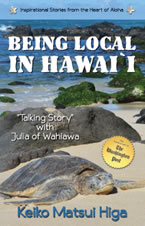March 30, 2014
Being Local in Hawai’i
“Talking Story” with Julia of Wahiawa
Keiko Matsui Higa
Aviva Publishing (2014)
ISBN: 9781940984155
New Book Gives Eye-Opening Picture of Hawaiian Diversity and Issues
 Julia Estrella is a multicultural woman if there ever was one, and in Being Local in Hawai’i, she tells the fascinating story of her multicultural life and diverse experiences. Her first name was chosen for her from the Bible, but Keiko is her Japanese name. Her father was Japanese, her mother Okinawan, and her husband Filipino. She has lived in Hawai’i and California, but she has traveled around the world, including Okinawa, the Philippines, Cuba, and Kenya. Born less than a year before the attack on Pearl Harbor, she grew up knowing many of the Japanese in Hawai’i and California, who were sent to the U.S. concentration camps for the Japanese. She experienced institutional racism through the tracking system in Hawaiian schools, and despite it, she went on to have a successful and meaningful career, pursuing higher education, serving many organizations, and being heavily involved in various churches.
Julia Estrella is a multicultural woman if there ever was one, and in Being Local in Hawai’i, she tells the fascinating story of her multicultural life and diverse experiences. Her first name was chosen for her from the Bible, but Keiko is her Japanese name. Her father was Japanese, her mother Okinawan, and her husband Filipino. She has lived in Hawai’i and California, but she has traveled around the world, including Okinawa, the Philippines, Cuba, and Kenya. Born less than a year before the attack on Pearl Harbor, she grew up knowing many of the Japanese in Hawai’i and California, who were sent to the U.S. concentration camps for the Japanese. She experienced institutional racism through the tracking system in Hawaiian schools, and despite it, she went on to have a successful and meaningful career, pursuing higher education, serving many organizations, and being heavily involved in various churches.
Julia’s story is fascinating, and even more so are the many diverse stories she shares with all the people she has met, known, and advocated for. “Talking story” for Julia is a term that means not just telling stories, but telling stories that will enrich our lives, enlighten us, make us wiser and better people, and call upon us to do more to make the world a better place.
By now you realize that this is not a book of “feel good” stories about Hawai’i, complete with palm trees and hula skirts. Julia does love Hawai’i for many reasons, but the inspirational message of her stories is directed toward raising awareness about the gifts we all have to offer as different people and the need to redress social injustices around the world, many of which parallel situations in Hawai’i. Julia has advocated for the homeless in Hawai’i. She has advocated for the end of apartheid in South Africa. She sympathizes with the movements to end the U.S. occupation of Hawai’i and Puerto Rico, and she has spoken up against the use of nuclear weapons and the presence of U.S. military bases overseas in Micronesia and Okinawa.
Julia is a lover and promoter of peace, but she is not afraid of committing civil disobedience—she’s been arrested three times in her efforts to help others. Nor is she afraid to speak the truth, as when she states that the only reason she didn’t end up in a concentration camp was that her parents were cheap laborers in the sugarcane and pineapple plantations, and to send all 150,000 Japanese in Hawai’i to concentration camps would have devastated the islands’ economy. “Productivity—a wonderful euphemism for cheap farm labor on the Hawaiian plantations—was the real reason why I did not end up in a concentration camp.”
There are sad moments in this book, but also humorous ones like the pidgin poem Julia includes about the computer problems she had while writing this book. But best of all are the hopeful and inspiring moments, such as when she described hearing Nelson Mandela speak at Oakland Stadium: “It was the only time I have felt the instantaneous unity of all peoples of color as hushed silence descended upon the crowd of thousands and Mandela walked on to that stage. As people stood up weeping for joy, I thought to myself, ‘This is heaven on earth.’”
Overall, Being Local in Hawai’i opened my eyes to the realities of Hawai’i, the diversity and injustices on our planet, and the never-ending need to work for social justice, understanding, tolerance, and also the embracing of other cultures, because in the end, we are all sharing this planet and must co-exist together.
— Tyler R. Tichelaar, Ph.D. and award-winning author of The Best Place

